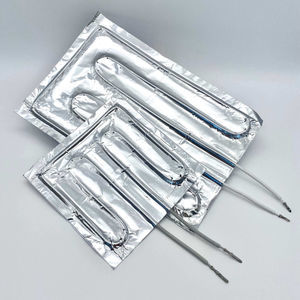
- Company
- Products
- Catalogs
- News & Trends
- Exhibitions
Flexible heating element UPPAflatscreen-printedPET

Add to favorites
Compare this product
Characteristics
- Type
- flat, flexible, screen-printed
- Material
- PET
- Applications
- industrial, automotive, for medical applications
- Other characteristics
- custom, compact, adhesive, smart, printed electronics
Description
Alper uses printing technologies consolidated over time and together with the innovative intent, has the opportunity to enter in new sectors, such as Printed Electronics. One of the most interesting applications of this technology is represented by resistances printed with silver ink. These heaters are produced through printing and deposition processes that allow to obtain extremely flexible heating elements that can be adapted to the needs of multiple applications.
The silver ink used to print these resistances is composed of nanometre silver particles suspended in a fluid. This type of ink is able to adhere to a wide range of surfaces, including plastic substrates such as PET which is the one used by Alper. Once printed on the PET substrate, the ink is baked to remove the volatile component and consolidate the silver particles into a compact and flexible structure. The result is a highly conductive and flexible resistance that can be easily integrated into a wide range of applications.
There are many applications for silver ink screen-printed heating resistances. Thanks to their flexibility and ability to adapt to non-flat surfaces, these heating elements are particularly useful in applications where flexibility is a requirement.
VIDEO
Catalogs
No catalogs are available for this product.
See all of ALPER S.R.L.‘s catalogsOther ALPER S.R.L. products
Flexible heating element / Self-adhesive heating foil
Related Searches
- Resistance heater
- Tubular resistance heater
- Drum heater
- Heating cable
- Flat resistance heater
- Flexible resistance heater
- Industrial resistance heater
- Heating jacket
- PTC resistance heater
- Compact resistance heater
- Silicone resistance heater
- Electric heating jacket
- Resistance heater with thermostat
- Custom resistance heater
- Food drum heater
- Oil drum heater
- Belt drum heater
- Freeze protection heating cable
- Constant-wattage heating cable
- Plastic drum drum heater
*Prices are pre-tax. They exclude delivery charges and customs duties and do not include additional charges for installation or activation options. Prices are indicative only and may vary by country, with changes to the cost of raw materials and exchange rates.








